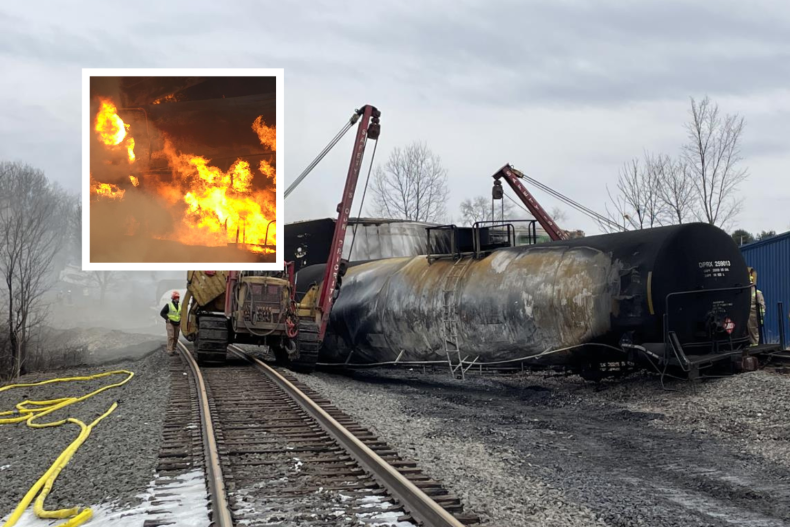Ohio Train Disaster: Investigation Into Long-Term Toxic Chemical Presence In Buildings

Table of Contents
Assessing the Extent of Building Contamination
The Ohio train derailment released a cocktail of hazardous chemicals, most notably vinyl chloride, butyl acrylate, and ethylhexyl acrylate. These substances pose a significant risk of long-term contamination because of their ability to penetrate various building materials.
Vinyl Chloride and Other Toxic Substances
- Penetration of Building Materials: Vinyl chloride, a known carcinogen, is particularly concerning due to its volatility and ability to seep into porous materials like drywall, insulation, and carpeting. Butyl acrylate and ethylhexyl acrylate, while less volatile, can also permeate building materials, potentially creating long-lasting contamination. These chemicals can accumulate in HVAC systems, further spreading contamination throughout the building.
- Persistence of Chemicals: The persistence of these chemicals varies depending on the material they've infiltrated and environmental factors. Some may off-gas slowly over time, leading to continued exposure, while others may bind to building materials, creating a more persistent source of contamination. The complex nature of building materials means that thorough decontamination is challenging.
- Difficulty of Detection: Detecting low-level contamination is particularly difficult. Sophisticated testing methods are required to accurately assess the extent of contamination, and the presence of multiple chemicals further complicates the analysis.
Methods of Contamination Assessment
Several methods are employed to assess building contamination following the Ohio train derailment:
- Air Quality Testing: This involves measuring the concentration of volatile organic compounds (VOCs), including vinyl chloride and other released chemicals, in the air inside buildings. However, air quality testing alone may not reveal contamination trapped within building materials.
- Surface Sampling: Surface samples from walls, floors, and other surfaces are analyzed to determine the presence and concentration of chemicals. This method is crucial in identifying localized areas of high contamination.
- Material Analysis: This involves testing building materials themselves—such as drywall, insulation, and carpeting—to assess the degree of chemical penetration. This is often a destructive method, requiring samples to be removed and analyzed in a laboratory.
The limitations of each method highlight the importance of a comprehensive testing strategy that combines multiple approaches. Independent verification of test results by external laboratories is critical to ensure accuracy and transparency.
Long-Term Health Effects of Exposure
Exposure to the chemicals released in the Ohio train derailment can lead to a range of acute and chronic health effects.
Acute and Chronic Health Impacts
- Acute Effects: Short-term exposure can cause respiratory irritation, headaches, nausea, and dizziness. Higher levels of exposure can lead to more severe symptoms.
- Chronic Effects: Long-term exposure to vinyl chloride is linked to a significantly increased risk of liver cancer, brain cancer, and other cancers. Exposure to other released chemicals can also result in respiratory problems, neurological issues, and other long-term health complications. Attributing specific health problems solely to the chemical exposure can be challenging due to the complex nature of health conditions and other contributing factors.
Vulnerable Populations
Certain populations are particularly vulnerable to the long-term effects of chemical exposure:
- Children: Children are more susceptible due to their developing immune systems and higher respiratory rates.
- Elderly: The elderly often have pre-existing health conditions that make them more vulnerable to the adverse effects of chemical exposure.
- Individuals with Pre-existing Conditions: Those with respiratory illnesses, heart conditions, or other chronic health issues are at increased risk of experiencing more severe health problems.
Targeted monitoring and support programs are crucial for these vulnerable populations. Continued health surveillance and access to quality healthcare are essential to address the potential long-term health consequences.
The Role of Environmental Remediation and Building Decontamination
Effective remediation strategies are vital for mitigating the long-term risks associated with building contamination.
Cleanup Strategies
Several approaches may be employed to decontaminate affected buildings:
- Air Purification: Using specialized air filtration systems to remove volatile chemicals from the air.
- Surface Cleaning: Thorough cleaning of surfaces to remove deposited chemicals. However, this is often ineffective for chemicals deeply embedded in porous materials.
- Demolition: In cases of severe contamination, demolition and complete rebuilding might be necessary. This is a costly option, but it may be the only way to ensure the long-term safety of the building.
The challenges of decontaminating porous building materials, coupled with the potential cost and logistical complexities of these strategies, highlight the need for careful planning and comprehensive risk assessment. Long-term monitoring is also essential to evaluate the effectiveness of remediation efforts.
Regulatory Oversight and Accountability
Government agencies, including the Environmental Protection Agency (EPA) and the Occupational Safety and Health Administration (OSHA), play a critical role in overseeing the cleanup process and ensuring accountability.
- Transparent Communication: Open and transparent communication with the affected community is paramount. Residents must have access to accurate information regarding the extent of contamination, the remediation efforts, and the potential health risks.
- Community Engagement: Meaningful community engagement is essential to build trust and ensure that the remediation efforts are effective and address the concerns of residents.
- Clear Guidelines and Regulations: Robust regulations and clear guidelines are needed to ensure the safety and effectiveness of building decontamination following environmental disasters.
Conclusion
The Ohio train disaster's long-term consequences extend far beyond the immediate emergency response. The potential for long-term toxic chemical presence in buildings demands a thorough, sustained investigation and remediation effort. Comprehensive building contamination assessments, aggressive cleanup strategies, and ongoing health monitoring are crucial to protecting the health and well-being of East Palestine residents. Continued vigilance and transparent communication from authorities are paramount to addressing this ongoing crisis. Understanding the lingering threat of toxic chemicals is vital for mitigating the long-term consequences of this tragedy. We must ensure the long-term safety of homes and businesses in the affected area, preventing further health issues linked to the Ohio train derailment. Demand accountability and participate in the ongoing dialogue surrounding the Ohio train disaster and its impact on the long-term safety of buildings in East Palestine.

Featured Posts
-
 John Wick 5 Confirmation And Production Details
May 11, 2025
John Wick 5 Confirmation And Production Details
May 11, 2025 -
 Tva Klubbar Vill Vaerva Thomas Mueller
May 11, 2025
Tva Klubbar Vill Vaerva Thomas Mueller
May 11, 2025 -
 Corporate Espionage Millions Lost Through Office365 Breach
May 11, 2025
Corporate Espionage Millions Lost Through Office365 Breach
May 11, 2025 -
 Tylas Coachella 2025 Outfit A Britney Spears Homage Or Original Design
May 11, 2025
Tylas Coachella 2025 Outfit A Britney Spears Homage Or Original Design
May 11, 2025 -
 Next Season In Focus Stevenson And Ipswich Town
May 11, 2025
Next Season In Focus Stevenson And Ipswich Town
May 11, 2025
